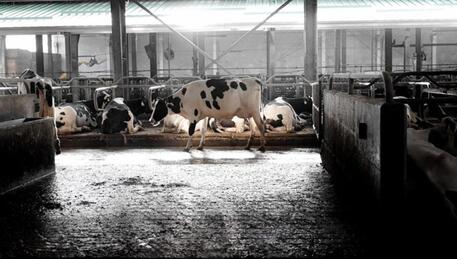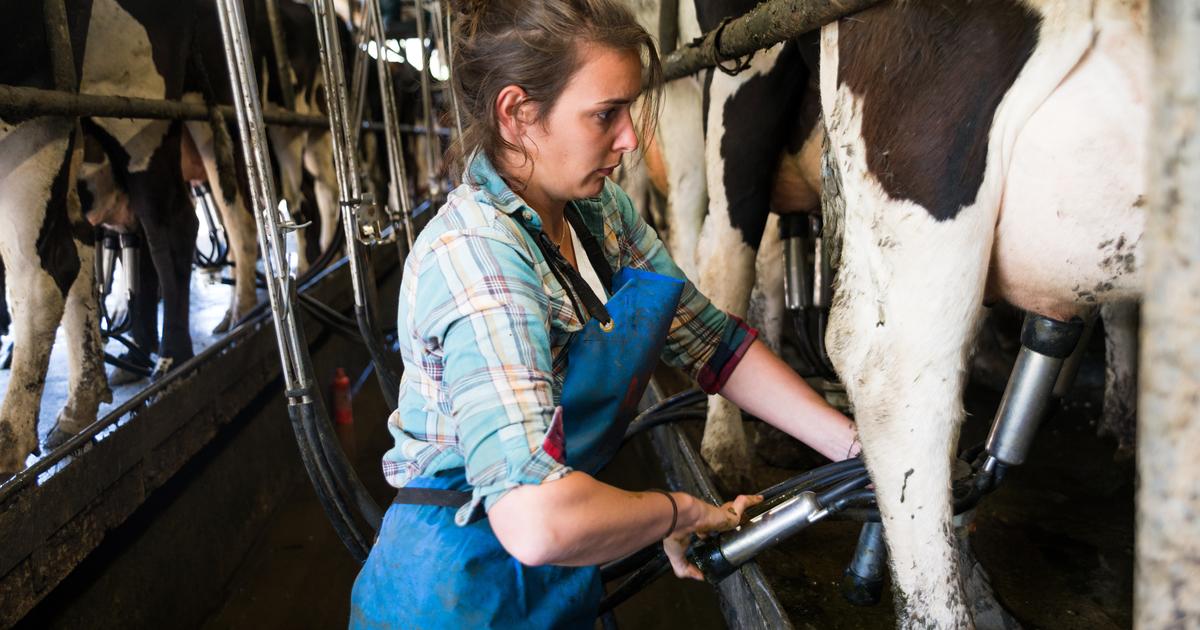There are times when having a future is a decision, a course that is taken with some urgency and with a lot of intuition.
Álvaro Llorente knows this well, who in the midst of a pandemic spent hours watching videos of robotic dairy farms and today observes with his own eyes the transformation that state-of-the-art technology is generating in the family business.
Mitikile
has been producing milk for more than fifty years in the town of Lincoln
, in western Buenos Aires.
Until 2018, there were three dairy farms with 200 cows each under a semi-pastoral system, during the day the cows grazed free and at night they were locked up.
With the entry into the company of the new generation Llorente, Álvaro and their sister Magdalena -and with the conviction and drive of Rafael, leader of the company and eternal seeker of new paradigms-, came a first important modification that was the confinement
of the rodeos in the so-called “dry lots”
, lots without grass to which all the necessary food is brought.
They had identified that they had too many heads for the available grass and that they were grazing inefficiently, and from enclosure and better fodder management they managed to increase production, going from 23 to 27 liters per cow per day, and they were also able to add one hundred cows per dairy. .
Along the street of the feeder passes the automatic feeder bringing the food closer to avoid waste and ensure even consumption.
This is how they were when the pandemic hit: three dairy farms, almost a thousand milking cows, acceptable productivity and a few families living in the fields.
But the structure was beginning to suffer, it was clear that
the balance was fragile and that another twist had to be given
.
So they got together, decided to do strategic planning and began to spy on the future.
"One of the decisive factors when deciding to take a technological leap was the possibility of
getting motivated again, getting involved, taking on a new family challenge
," Álvaro highlighted in a dialogue with
Clarín Rural
.
The mixture of alfalfa, corn silage and protein concentrates has to be tailored to each category.
In the first place, they asked themselves how many cows they could feed with their own resources, so as not to depend on the fluctuations of the market.
They could go out and buy protein concentrates, some megabale of alfalfa, but the corn silage, ryegrass, oats and greens had to come from their own field, and with the productive potential of 1,000 hectares of regular quality, they estimated that they could maintain up to 1,200
. milking cows, plus the recuperates
.
Then they wondered about the most efficient way to milk them.
Having three dairy farms implies a lot of logistics and wear and tear on machines taking herds and reserves from one end of the field to the other, it
became evident that they had to centralize the milking area for the entire herd
.
And also, to keep up with the world trend, the cows had to be indoors, with greater comfort.
To the hours and hours of watching videos, they added a few trips around the country visiting dairy farms, especially Córdoba.
"I admire the initiative of the people of Cordoba, how they are going forward," says Llorente from the shadow of the maternity shed, the first roof they put up for the cows.
They analyzed several alternatives and understood that the best option for them was to have what is called a cold bed, which in comparison to compost beds requires less maintenance.
The cows sleep directly on the ground and twice a day a chisel is passed
to break down the dung and level the ground.
It is simpler but more meters are needed per animal, while the sheds with compost beds calculate 12 square meters per head, in the cold bed it is 18.
The bedding is made of dirt, there are 18 square meters per cow and the floor is chiseled twice a day.
The maternity shed was built three years ago with wooden posts and a plastic canvas roof, it was the first small step in pursuit of animal comfort.
Then came the big leap.
Based on a very convenient financing plan offered by a distributor of a global technology firm, which allows them to
pay for the investment with liters of milk for five years
, they were encouraged to build a fourth fully robotic dairy that, one year after start working
already yields daily averages of 10 liters of milk more per cow.
The maternity shed, the first one they built.
How the robotic dairy works
Today, in a 120 by 52 meter shed, Mitikile milks 230 cows.
In addition to the cold bed, which occupies most of the space, on one side there is a street with a cement floor through which the mixer passes, leaving the food.
In the area of the feeder there are
sprinklers and fans that turn on automatically
when the temperature exceeds 24 degrees, and a circular robot passes by every now and then bringing the food closer to
avoid waste and that consumption is even
.
At one end of the barn are the four brand new milking robots that
the cows approach when they feel the need, at any time of the day, without human intervention
.
Each cow has a collar with a chip
that the robots read when the animal enters, the compartment adapts according to its size -small, medium or large-, an arm positions itself and places the teat cups on the udders.
While the cows enjoy a special portion of food coming down from a hopper, the robots
wash the teats, stimulate them and extract small samples of milk for analysis
.
If they identify a strange color, the presence of blood or an excess of somatic cells, they notify the system that that cow must be checked and they discard the milk from that milking.
During milking, the system shows in real time the amount of milk that is coming out of each quarter, among other data that help to carry out a
comprehensive management of health and nutrition.
, and at the end of the session, seal the nipples.
During milking, the robots report in real time the amount of milk that comes out of each teat, among other data.
The cows go to the robots voluntarily two, three or even five times a day, but less than four hours apart they are not allowed to be milked.
If a rogue appears looking for an extra helping of special food when it's not her due, the robot gently opens the door for her to go on.
In addition, when the cows have already given 80 percent of their milk, the robots do not give them more balanced, and if there is a cow that requires special treatment, it is automatically set aside in a specific pen.
The big difference with manual dairy is that milking is voluntary, the cow goes when she feels the need.
In the new dairy,
the average production is 37 liters per cow
and there are cows that at their peak reach 63 liters per day.
The collars, in addition to being the key to enter the milking sector, measure the hours of feeding, rumination and activity of the cows and provide multiple
indicators of health and heat,
facilitating and making management more precise.
“One guideline that we set ourselves was to make everything as automated as possible, thus reducing the possibility of error to a minimum.
A very important change is achieved
in the well-being of the cow, and efficiency comes from comfort
”, summarizes Llorente, and clarifies:
“Robotization is not an end, it is a means”
.
At this point in the story, a clarification is worthwhile: the Llorentes do not do all this for the love of technology or to work less.
What drives the movement is a horizon that can already be glimpsed in the leading dairy farms in the United States, that of cows that with the same genetics used in Argentina reach averages of 75 liters of milk per day
.
That is where they want to go in Mitikile
, and they know that the only way to maintain the comfort of these cows, who need many milkings per day, is by robotizing the task and ensuring
the perfection of a routine
365 days a year, without carelessness, holidays or emotions that can cause an error.
The future, in this tambo, has already arrived.
The question that inevitably arises is: will it continue to generate employment and take root in the countryside or will robots replace the human factor?
“The dairy, even though it is automated, has its routines and still needs the same number of employees.
You have to clean the lens of the cameras that the robots use, you have to teach the cows to enter the robots… Of course, now
the dairy farmer has the challenge of handling much more information
”, concludes Llorente.
Innovation doesn't stop
When facing their new adventure, the Llorentes set the premise that everything be as automatic as possible.
While the milking robots do their thing and Álvaro receives all the data from each cow in real time on his cell phone, you can see an arrimador robot that passes through the street several times a day bringing the food to the cows so they can consume it. level and avoid waste, and at the end of its task it parks itself and plugs into the power charger.
The air conditioning is also activated by itself, and the cleaning of the entire dairy is also activated.
At 5 in the morning, when fewer cows decide to be milked, one of the three daily flushes of the system is activated.
The streets and the feeder are cleaned every 4-5 hours by flushing, and this water ends up in settling basins to then circulate again.
Everything closes, but there is still a way to go.
“One benefit of the robot is modularity.
Mitikile's master plan is to add the robots by four until they have four identical sheds, one next to the other, to replace the old dairy”, says Llorente.
In Mitikile, three traditional dairy farms with 300 cows each continue to function.
In this way, over time
the goal of centralizing the milking of 1,200 cows will be achieved, with greater productivity and efficiency
.
And meanwhile there are other technologies to add.
In one of the traditional dairy farms, which are still working, they incorporated an automatic separator that saves dairy farmers a few runs.
Next to the maternity shed, the land is ready for the construction of a delivery and calostrum room, and a few meters from there they are planning a new collective guachera with an automatic breast-feeder.
In the background you can see the silos, the mixer preparing the rations for each category, the silo bags with reserves, the rearing heifers, batches of corn that will soon be chopped... Today Mitikile delivers 30,000 liters of milk per day, and with organizational and technological innovation he dreams of multiplying his production and continuing to give life to this corner of the humid pampas.









